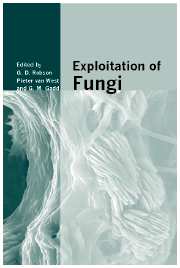Book contents
- Frontmatter
- Contents
- List of contributors
- Preface
- I Comparative and functional fungal genomics
- II Bioactive molecules
- 3 The biosynthesis of polyketides, acyl tetramic acids and pyridones by filamentous fungi
- 4 Fungal metabolites as lead structures for agriculture
- 5 Molecular and genetic analysis of symbiosis expressed secondary metabolite genes from the mutualistic fungal endophytes Neotyphodium lolii and Epichloë festucae
- 6 What can genomics tell us about secondary metabolism in Aspergillus?
- III Protein folding and secretion
- IV Fungal bioremediation
- V Fungal biocontrol of pests
- Index
- References
6 - What can genomics tell us about secondary metabolism in Aspergillus?
from II - Bioactive molecules
Published online by Cambridge University Press: 05 October 2013
- Frontmatter
- Contents
- List of contributors
- Preface
- I Comparative and functional fungal genomics
- II Bioactive molecules
- 3 The biosynthesis of polyketides, acyl tetramic acids and pyridones by filamentous fungi
- 4 Fungal metabolites as lead structures for agriculture
- 5 Molecular and genetic analysis of symbiosis expressed secondary metabolite genes from the mutualistic fungal endophytes Neotyphodium lolii and Epichloë festucae
- 6 What can genomics tell us about secondary metabolism in Aspergillus?
- III Protein folding and secretion
- IV Fungal bioremediation
- V Fungal biocontrol of pests
- Index
- References
Summary
Introduction
Genome resources for filamentous fungi have improved dramatically in the past few years. Since the publication of the N. crassa genome (Galagan et al., 2003) the pace has accelerated, with many projects completed or nearing completion (Table 6.1), and more underway. The number of researchers investigating the molecular genetics of filamentous fungi is relatively small, and the number of species very large, such that our efforts are spread rather thinly compared to the S. cerevisiae community, for example. Nevertheless, there are indications that these new resources will be extremely beneficial for mycology, and will attract new researchers into the field. Unlike yeasts, filamentous fungi are known for their ability to produce a wide variety of secondary metabolites, which are often of importance to man as useful drugs or harmful toxins (Keller, Turner & Bennett, 2005). Studies over the past 20 years have led to the characterization of some of the biosynthetic pathways and the gene clusters which encode them, for example, the penicillin/cephalosporin and aflatoxin/sterigmatocystin pathways (Brakhage, 1998; Hicks, Shimuzu & Keller, 2002). Since these gene clusters often span substantial regions of the genome, their isolation and sequencing was a major undertaking (Keller & Hohn, 1997). The genome sequences now emerging provide us with easily recognizable gene clusters as a starting point for further investigations, show us the entire secondary metabolic capacity of any species, and pose new questions about how the secondary metabolic repertoire of genera and species has evolved.
- Type
- Chapter
- Information
- Exploitation of Fungi , pp. 78 - 92Publisher: Cambridge University PressPrint publication year: 2007



